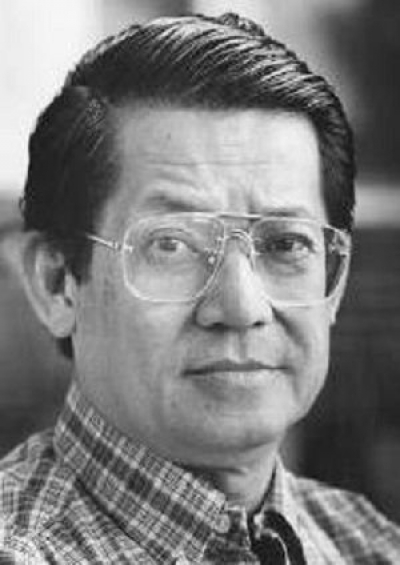Benigno "Ninoy" Aquino Jr., a former Philippine senator, was assassinated on Sunday, August 21, 1983, on the tarmac of Manila International Airport (now named Ninoy Aquino International Airport in his honor). A longtime political opponent of President Ferdinand Marcos, Aquino had just landed in his home country after three years of self-imposed exile in the United States when he was shot in the head while being escorted from an aircraft to a vehicle that was waiting to transport him to prison. Also killed was Rolando Galman, who was falsely accused of Aquino's murder.
Aquino was elected to the Philippine Senate in 1967 and shortly thereafter began speaking out against Marcos's authoritarian rule. He was imprisoned on trumped up charges shortly after Marcos's 1972 declaration of martial law. In 1980, he had a heart attack in prison and was allowed to leave the country two months later by Marcos' wife, Imelda. He spent the next three years in exile near Boston before deciding to return to the Philippines.
Aquino's assassination is credited with transforming the opposition to the Marcos regime from a small, isolated movement into a national crusade. It is also credited with thrusting Aquino's widow, Corazon Aquino, into the public spotlight and her running for president in the 1986 snap election. Although Marcos was officially declared the winner of the election, widespread allegations of fraud and illegal tampering on Marcos's behalf are credited with sparking the People Power Revolution, which resulted in Marcos fleeing the country and conceding the presidency to Mrs. Aquino.
Although many, including the Aquino family, maintain that Marcos ordered Aquino's assassination, this was never definitively proven. An official government investigation ordered by Marcos shortly after the assassination led to murder charges against 25 military personnel and one civilian, all of whom were acquitted by the Sandiganbayan (special court). After Marcos was ousted, another government investigation under President Corazon Aquino's administration led to a retrial of 16 military personnel, all of whom were convicted and sentenced to life imprisonment by the Sandiganbayan. The Supreme Court affirmed the decision and rejected later motions by the convicted soldiers for a retrial. One of the convicts was subsequently pardoned, three have died in prison, and the remainder had their sentences commuted at various times; the last convicts were released from prison in 2009.
Benigno Simeon "Ninoy" Aquino Jr., , (November 27, 1932 – August 21, 1983) was a Filipino politician who served as a senator of the Philippines (1967–1972) and governor of the province of Tarlac. He was the husband of Corazon Aquino—who, after his death, eventually became the president of the Philippines—and father of a later president, Benigno Aquino III. Aquino, together with Gerardo Roxas and Jovito Salonga, helped form the leadership of the opposition towards then President Ferdinand Marcos. He was the aggressive leader who together with the intellectual leader Sen. Jose W. Diokno led the overall opposition.
Shortly after the imposition of martial law, Aquino was arrested in 1972 along with others associated with the New People's Army's armed insurgency and incarcerated for seven years. He has been described as Marcos' "most famous political prisoner". He founded his own party, Lakas ng Bayan and ran in the 1978 Philippine parliamentary election, but all the party's candidates lost in the election. In 1980, he was permitted by Marcos to travel to the United States for medical treatment following a heart attack. During the early 1980s he became one of the most notable critics of the Marcos regime, and enjoyed popularity across the US due to the numerous rallies he attended at the time.
As the situation in the Philippines worsened, Aquino decided to return to face Marcos and restore democracy in the country, despite numerous threats against it. He was assassinated at the Manila International Airport on August 21, 1983, upon returning from his self-imposed exile. His death revitalized opposition to Marcos; it also catapulted his widow, Corazon, into the political limelight and prompted her to successfully run for a six-year term as president as a member of the United Nationalist Democratic Organization (UNIDO) party in the 1986 snap election.
Among other public structures, Manila International Airport has since been renamed Ninoy Aquino International Airport in his honor, and the anniversary of his death is a national holiday.

1983Aug, 21
Philippine opposition leader Benigno Aquino, Jr. is assassinated at the Manila International Airport (now renamed Ninoy Aquino International Airport in his honor).
Choose Another Date
Events on 1983
- 24Feb
Japanese American internment
A special commission of the United States Congress condemns the Japanese American internment during World War II. - 19Jul
CT scan
The first three-dimensional reconstruction of a human head in a CT is published. - 24Jul
Sri Lankan Civil War
The Black July anti-Tamil riots begin in Sri Lanka, killing between 400 and 3,000. Black July is generally regarded as the beginning of the Sri Lankan Civil War. - 1Sep
Korean Air Lines Flight 007
Cold War: Korean Air Lines Flight 007 is shot down by a Soviet Union jet fighter when the commercial aircraft enters Soviet airspace, killing all 269 on board, including Congressman Lawrence McDonald. - 12Sep
Los Macheteros
A Wells Fargo depot in West Hartford, Connecticut, United States, is robbed of approximately US$7 million by Los Macheteros.

 English
English  español
español  français
français  português
português  русский
русский  العربية
العربية  简体中文
简体中文 